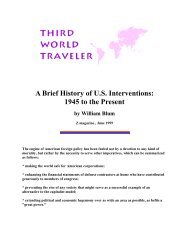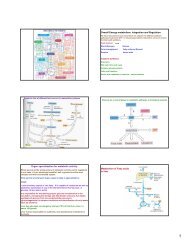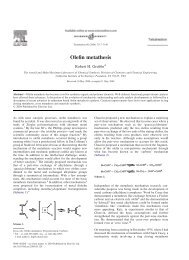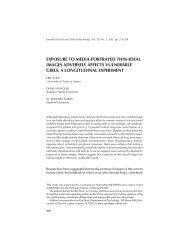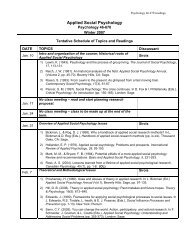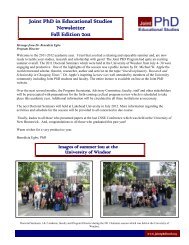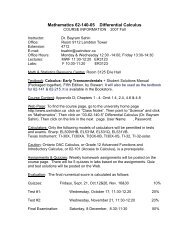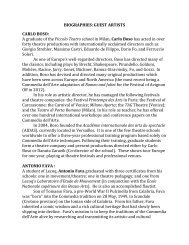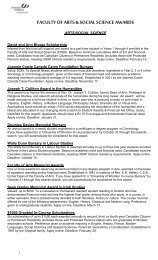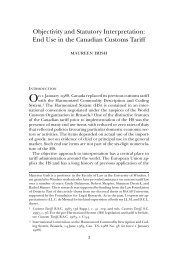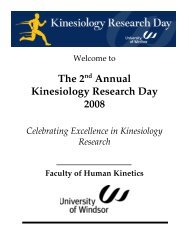Transition metal complexes in organic synthesis. Part 47
Transition metal complexes in organic synthesis. Part 47
Transition metal complexes in organic synthesis. Part 47
You also want an ePaper? Increase the reach of your titles
YUMPU automatically turns print PDFs into web optimized ePapers that Google loves.
or nonacarbonyldiiron <strong>in</strong> the presence of the 1-azabuta-<br />
1,3-diene 1. Thus, the 1-azabuta-1,3-diene-catalyzed complexation<br />
of cyclohexa-1,3-diene 3 with pentacarbonyliron affords<br />
complex 4 quantitatively (Scheme 2). 7<br />
Scheme 2<br />
The catalytic complexation of cyclohexadiene 3 is proposed<br />
to be <strong>in</strong>itiated by a nucleophilic attack of the im<strong>in</strong>e nitrogen of<br />
the 1-azabutadiene 1 at one of the carbonyl ligands of<br />
pentacarbonyliron (Scheme 3). 7 Loss of carbon monoxide by<br />
<strong>in</strong>ternal ligand displacement transforms the result<strong>in</strong>g (carbamoyl)tetracarbonyliron<br />
complex 5 <strong>in</strong>to the (h 3-allyl) (carbamoyl)tricarbonyliron<br />
complex 6. Complex 6 isomerizes by<br />
haptotropic migration of the tetracarbonyliron fragment first to<br />
the (h 2-olef<strong>in</strong>)tetracarbonyliron complex 7 and then to the (h 1im<strong>in</strong>e)tetracarbonyliron<br />
complex 8. Further loss of a carbonyl<br />
ligand from 8 generates the (h 1-im<strong>in</strong>e)tricarbonyliron complex<br />
9, which is <strong>in</strong> equilibrium with the stable (h 4-1-azabutadiene)tricarbonyliron<br />
complex 2 (cf. Scheme 1) by haptotropic<br />
migration of the tricarbonyliron fragment. Reaction of the<br />
tricarbonyliron complex 2 with excess pentacarbonyliron leads<br />
to the hexacarbonyldiiron complex 11, which was structurally<br />
confirmed by X-ray analysis. 7 The vacant coord<strong>in</strong>ation site of<br />
the crucial 16-electron <strong>in</strong>termediate 9 may be filled by h 2coord<strong>in</strong>ation<br />
of cyclohexadiene 3 to provide complex 10. Loss<br />
of the 1-azabutadiene regenerates the catalyst 1 and haptotropic<br />
(h 2 ? h 4) migration of the tricarbonyliron fragment affords<br />
complex 4.<br />
Optically active planar chiral tricarbonyliron–diene <strong>complexes</strong><br />
can be obta<strong>in</strong>ed directly by catalytic asymmetric<br />
complexation of the correspond<strong>in</strong>g prochiral ligands with the<br />
transition <strong>metal</strong> fragment. Us<strong>in</strong>g chiral 1-azabuta-1,3-dienes <strong>in</strong><br />
the catalytic complexation described above an enantioselective<br />
coord<strong>in</strong>ation of prochiral 1,3-dienes to the tricarbonyliron<br />
fragment with useful asymmetric <strong>in</strong>ductions was achieved. 8<br />
Catalytic complexation of 1-methoxycyclohexa-1,3-diene (12)<br />
with pentacarbonyliron us<strong>in</strong>g the (R)-camphor-derived 1-azadiene<br />
(R)-13 afforded the tricarbonyliron complex (S)-14, while<br />
catalyst (S)-13 led to complex (R)-14 (Scheme 4).<br />
Current research <strong>in</strong> this area focusses on the development of<br />
more efficient chiral catalysts useful for the asymmetric<br />
152 Chem. Soc. Rev., 1999, 28, 151–157<br />
Scheme 3<br />
Scheme 4<br />
catalytic complexation of a broad range of prochiral buta-<br />
1,3-diene and cycloalka-1,3-diene ligands. Thus, this method<br />
should facilitate the access to chiral nonracemic tricarbonyliron–diene<br />
<strong>complexes</strong> as start<strong>in</strong>g materials for enantioselective<br />
<strong>organic</strong> <strong>synthesis</strong>.<br />
3 Applications of tricarbonyliron–butadiene<br />
<strong>complexes</strong><br />
Acyclic tricarbonyliron–butadiene <strong>complexes</strong> represent useful<br />
start<strong>in</strong>g materials for the <strong>synthesis</strong> of acyclic polyunsaturated<br />
natural products, e.g. the metabolites result<strong>in</strong>g from the<br />
5-lipoxygenase pathway of the arachidonic acid cascade. 3<br />
The stereoselective Friedel–Crafts acylation of tricarbonyliron–butadiene<br />
<strong>complexes</strong> <strong>in</strong>itially affords the Z-dienones,<br />
which on acid-catalyzed isomerization provide the thermodynamically<br />
more stable E-dienones. 9 This method was applied to<br />
an enantioselective total <strong>synthesis</strong> of the natural leukotriene<br />
(2)-5(S),6(S)-LTA4 methyl ester (18) (Scheme 5). 10 Friedel–<br />
Crafts acylation of the enantiopure iron complex of trans-penta-<br />
2,4-dienoic 2,2,2-trichloroethyl ester 15 us<strong>in</strong>g the acid chloride<br />
of adipic acid monomethyl ester afforded complex 17 which<br />
was subsequently converted to the LTA4 methyl ester 18.<br />
The planar chiral complex tricarbonyl[h 4-methyl (2E,4E)-<br />
6-oxohexa-2,4-dienoate]iron (19) is easily separated <strong>in</strong>to the<br />
enantiomers by resolution with ephedr<strong>in</strong>e. 11,12 Start<strong>in</strong>g from<br />
this chiral build<strong>in</strong>g block an eight-step enantioselective total



